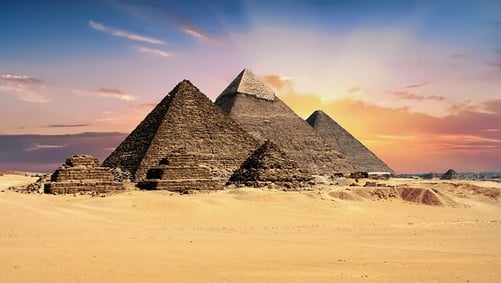Are you taking AP World History this year? Or considering taking it at some point in high school? Then you need to read this AP World History study guide. Instead of cramming every single name, date, and place into your head, learn how to study for the AP World History exam so that you can learn the major ideas and feel ready for test day. We'll also go over some key strategies you can use to help you prepare effectively.
The AP World History test is challenging—just 13.2% of test takers got a 5 in 2021. But if you study correctly throughout the year, you could be one of the few students who aces this test. Below are six tips to follow in order to be well prepared for the AP World History exam. Read through each one, apply them to your test prep, and you'll be well on your way to maximizing your score!
Why You Should Study for the AP World History Test
Is it really that important to study for the AP World History test? Absolutely! But why?
Let's start by taking a look at the kinds of scores students usually get on the exam. The following chart shows what percentage of test takers received each possible AP score (1-5) on the AP World History test in 2022:
| AP Score | Percentage of Test Takers Who Received Score |
| 5 | 13.2% |
| 4 | 21.9% |
| 3 | 27.0% |
| 2 | 23.7% |
| 1 | 14.3% |
Source: The College Board
As you can see, roughly 49% of test takers scored a 2 or 3, about 35% scored a 4 or 5, and only 14% scored a 1. Since most test takers scored a 3 or lower on this test, it's safe to say that a lot of AP World History students are not scoring as well as they could be. (That said, the test underwent some big changes beginning in the 2019-2020 school year, so we can't make too many direct comparisons between this new version of the test and the old one. We will talk more about these changes in the next section.)
While a 3 is not a bad AP score by any means, some colleges such as Western Michigan University require at least a 4 in order to get credit for some exams. If the schools you're applying to want a 4 or higher, putting in ample study time for the test is a definite must.
In addition, if you're applying to highly selective schools, a 5 on the AP World History test (or any AP test, really) could act as a tipping point in your favor during the admissions process.
Finally, getting a low score on this test—i.e., a 1 or 2—might make colleges doubt your test-taking abilities or question your potential to succeed at their school. You don't want this to happen!
What's on the AP World History Exam?
Before we give you our six expert study tips for AP World History, let's briefly go over the structure and content of the test.
The AP World History exam consists of two sections: Section 1 and Section 2. Each section also consists of two parts: Part A and Part B. Here's what you'll encounter on each part of each World History section:
| Section | Question Type | Time | # of Questions | % of Score |
| 1A | Multiple Choice | 55 mins | 55 | 40% |
| 1B | Short Answer | 40 mins | 3 (for third, choose 1 of 2 prompts) | 20% |
| 2A | Document-Based Question (DBQ) | 60 mins (including 15-min reading period) | 1 | 25% |
| 2B | Long Essay | 40 mins | 1 (choose 1 of 3 prompts) | 15% |
And here is an overview of the types of tasks you'll be asked to perform:
- Analyze historical texts as well as historians' opinions and interpretations of history
- Assess historical documents and make an argument to support your assessment
- Write an essay concerning an issue in world history
Note that as of the 2019-2020 school year, AP World History is now much smaller in scope and is called AP World History: Modern (another course and exam called AP World History: Ancient is in the process of being made by the College Board).
These changes have been put in place mainly as a response to ongoing complaints that the original World History course was way too broad in scope, having previously covered thousands of years of human development. Hopefully, this will make the test somewhat easier!
Now that you understand exactly how the AP World History test is set up, let's take a look at our six expert study tips for it.
How to Study for AP World History: 6 Key Tips
Below are our top tips to help you get a great score on the AP World History test.
Tip 1: Don't Try to Memorize Everything
If you start your AP World History class with the expectation of memorizing the entirety of human history, think again.
Although AP World History tests a wide span of time, you aren't expected to learn every tiny detail along the way; rather, this course focuses on teaching major patterns, key cultural and political developments, and significant technological developments throughout history.
Starting in 2019-2020, the AP World History course and exam will be arranged in nine units, which cover a range of periods starting around 1200 CE and ending with the present:
| AP World History (Modern) Unit | Time Period | % of Exam |
| Unit 1: The Global Tapestry | 1200-1450 | 8-10% |
| Unit 2: Networks of Exchange | 8-10% | |
| Unit 3: Land-Based Empires | 1450-1750 | 12-15% |
| Unit 4: Transoceanic Interconnections | 12-15% | |
| Unit 5: Revolutions | 1750-1900 | 12-15% |
| Unit 6: Consequences of Industrialization | 12-15% | |
| Unit 7: Global Conflict | 1900-present | 8-10% |
| Unit 8: Cold War and Decolonization | 8-10% | |
| Unit 9: Globalization | 8-10% |
For each period, you should know the major world powers and forces driving politics, economic development, and social/technological change; however, you don't have to have every detail memorized in order to do well on the test. Instead, focus on understanding big patterns and developments, and be able to explain them with a few key examples.
For instance, you don't necessarily need to know that in 1492 Columbus sailed the ocean blue; you also don't need to know the details of his voyages or the particulars of his brutality. Nevertheless, you should be able to explain why the European colonization of the Americas happened, as well as the economic effects it had on Europe, Africa, and the Americas, and how colonization impacted the lives of people on these three continents.
Knowing a few concrete examples is essential to succeeding on the short-answer section. Short-answer questions 1 and 2 will present you with a secondary source and a primary source, respectively, and then ask you to provide several examples or reasons for a broader theme or historical movement that relates to the information provided.
You'll have flexibility in what specific examples you choose, just so long as they are relevant. The short-answer section is three questions long and worth 20% of your total test score. You will have 40 minutes to complete it.
Concrete examples can also bolster your essays and improve your ability to break down multiple-choice questions on the topic; however, focus first on understanding the big picture before you try to memorize the nitty-gritty.
If you're coming from AP US History, this advice might seem odd. But unlike US History, which is more fine-grained, the AP World History exam writers do not expect you to know everything, as they test a much larger topic. AP US History is essentially a test of 400 years of history in one location, so it's fair to expect students to know many proper names and dates.
But for World History, that same level of detail isn't expected; this test takes place across 800 years all around the world. Instead, you should focus on understanding the general patterns of important topics through history. This won't only save you time but will also keep you sane as your textbook hurls literally hundreds of names, places, and dates at you throughout the year.
Speaking of your textbook ...
Tip 2: Keep Up With Your Reading!
When it comes to AP World History, you can't sleep through the class all year, skim a prep book in April, and then expect to get a perfect 5 on the test. You're learning a huge chunk of human history, after all! Trying to cram for this test late in the game is both stressful and inefficient because of the sheer volume of material you have to cover.
And all that reading would hurt your eyes.
Instead, keep up with your reading and do well in your World History class to ensure you're building a strong foundation of knowledge throughout the year. This way, when spring comes, you can focus on preparing for the exam itself and the topics it's likely to test, as opposed to frantically trying to learn almost a thousand years of human history in just two months.
If your teacher isn't already requiring you to do something like this, be sure to keep notes of your readings throughout the school year. This could be in the form of outlines, summaries, or anything else that's useful to you. Taking notes will help you process the readings and remember them better. Your notes will also be an invaluable study tool in the spring.
Finally, check the website of whatever textbook your class uses. Many textbook websites have extra features, such as chapter outlines and summaries, which can be excellent study resources for you throughout the year.
Tip 3: Read a Prep Book (or Two) in the Spring
Even if you keep up with AP World History throughout the year, you're probably going to be a bit hazy on topics you learned in September when you start studying for the test in March or April. This is why we recommend getting a prep book, which will provide a much broader overview of world history, focusing especially on topics tested on the exam. (Make sure it's an updated book for the new Modern focus of the AP World History course and exam!)
If you've been learning well throughout the school year, reading a prep book will trigger your background knowledge and help you review. Think of your prep book as your second, much quicker pass through world history.
And in case you're wondering—no, the prep book alone will not fill you in on the necessary depth of knowledge for the entire test. You can't replace reading your textbook throughout the year with reading a prep book in the spring. The AP World History multiple-choice section especially can ask some pretty specific questions, and you'd definitely have blind spots if all you did is read a prep book and not an actual textbook.
Furthermore, you wouldn't be able to explain examples in your essay in as much detail if you've only read a few paragraphs about major historical events.
Tip 4: Get Ready to Move at 1 MPQ (Minute per Question)
To prepare for the AP World History exam, knowing the material is just half the battle. You also need to know how to use your time effectively, especially on the multiple-choice section.
The multiple-choice section (Section 1, Part A) asks 55 questions in 55 minutes and is worth 40% of your total score. This gives you just one minute per question, so you'll have to move fast. And to be ready for this quick pace, practice is key.
Taking the AP World History exam without practicing first would be like jumping into a NASCAR race without a driver's license.
To practice pacing yourself, it's crucial that you get a prep book containing practice tests. Even if you've read your textbook diligently, taken notes, and reviewed the material, it's really important to practice actual multiple-choice sections so you can get used to the timing of the test.
Although there are a handful of stand-alone questions, most come in sets of three to four and ask you to look at a specific source, such as a graph, image, secondary source, or map. It's a good idea to skip and return to tough questions (as long as you keep an eye on the time!).
Your teacher should be giving you multiple-choice quizzes or tests throughout the year to help you prepare for the test. If your teacher isn't doing this, it will, unfortunately, be up to you to find multiple-choice practice questions from prep books and online resources. See our complete list of AP World History practice tests here (and remember to find updated materials for the new 2020 Modern exam).
You need to create your own multiple-choice strategy as you study, such as using the process of elimination, being ready to read and analyze pictures and charts, and being constantly aware of your time. I recommend wearing a watch when you practice so you can keep an eye on how long you spend on each question. Just make sure it's not a smart watch—unfortunately, those aren’t allowed!
Finally, make sure to answer every question on the exam. There are no penalties for incorrect answers, so you might as well guess on any questions you're not sure about or have no time for.
In short, make sure you practice AP World History multiple-choice questions so that when you sit down to take the exam, you'll feel confident and ready to move fast.
Tip 5: Practice Speed-Writing for the Free-Response Section
The AP World History exam has two essay questions that together account for 40% of your AP World History score. You'll get 60 minutes for the Document-Based Question, or DBQ, including a 15-minute reading period; the DBQ is worth 25% of your final grade. After, you will get 40 minutes for the Long Essay, which is worth 15% of your score.
For each essay, you need to be able to brainstorm quickly and write an essay that answers the prompt, is well organized, and has a cogent thesis. A thesis is a one-sentence summary of your main argument. For the sake of AP essays, it's best to put your thesis at the end of the introductory paragraph so the grader can find it quickly.
When organizing your essay, have each paragraph explain one part of the argument, with a topic sentence (basically, a mini-thesis) at the beginning of each paragraph that explains exactly what you're going to say.
For the DBQ, you'll need to bring most of the provided documents into your argument in addition to your background knowledge of the period being tested. For example, in a DBQ about the effects of Spanish Influenza during World War I, you'd need to demonstrate your knowledge of WWI as well as your ability to use the documents effectively in your argument. See our complete guide to writing a DBQ here.
For the Long Essay, it's up to you to provide specific historical examples and show your broad understanding of historical trends. (Again, this is why doing your reading is so important, since you'll have to provide and explain your own historical examples!)
Throughout the year, your teacher should be having you do writing assignments, including in-class essays, to teach you how to write good essays quickly. Since you'll be writing your essays by hand for the test, you should ideally be writing your practice essays by hand as well. If you struggle with writing by hand quickly, you can build up your writing fluency (that is, your ability to quickly translate thoughts to words) by writing additional practice essays on your own.
If you need to work on writing fluency, it's best to practice with easier writing topics. First, find a journal prompt to write about (this website has hundreds). Next, set a timer; between 10 and 15 minutes is best. Finally, write as much (and as fast!) as you can about the prompt, without making any big mistakes in spelling or grammar.
When time's up, count how many words you wrote. If you do this a few times a week, you'll build up your writing speed, and your word counts will continue to grow. Once you've built up this skill, it will be much easier to tackle the AP World History free-response section.
You can also practice on your own using old AP World History free-response questions. However, note that the test was revised for 2019-20 (now its focus is only on 1200-present) and 2016-17, so old questions will have old content and instructions.
In fact, there actually used to be three essays on the AP World History test—in addition to the DBQ, there was a "Change Over Time" essay and a "Comparison" essay. Now, there's just one long essay. Be sure to compare older questions with the most up-to-date examples from the most current AP Course and Exam Description.
Tip 6: Take Practice Exams and Set a Target Score
In the spring, aim to take at least one full practice exam—ideally in late March or early April—once you've learned most of the World History material. By a full practice exam, we mean the entire AP World History test. Time yourself and take it in one sitting, following official time restrictions.
Why should you do this? It will give you a chance to experience what it's like to take a full AP World History exam before you sit for the real thing. This helps you build stamina and perfect your timing. All the practice in the world won't help you if you run out of steam on your last essay question and can barely think.
Also, set a target score for each section. Good news: you don't need to be aiming for 100% on Section 1 and perfect scores on every essay in Section 2 in order to secure a 5—the highest possible score. Far from it, actually!
The truth is that a high multiple-choice score (50/55) with average short-answer and free-response scores (say, 6/9 on short answer, 5/7 on the DBQ, and 4/6 on the long essay) can net you a score of 5. Likewise, an average multiple-choice score (35/55) with high short-answer and free-response scores (say, 8/9 on short answer, 6/7 on the DBQ, and 5/6 on the long essay) can also net you a 5.
Set realistic score targets based on your personal strengths. For example, a really good writing student might go the average multiple choice/strong essay route, while a stronger test taker might go the other way around. You could also be somewhere in-between.
In addition, don't be intimidated if your target score is a lot higher than your current scores. The whole point of practicing is to eventually meet your target!
Once you have a target score, practice, practice, practice! Use old exams, the practice exams in (high-quality) prep books, and the free-response questions linked above. You can even ask your teacher for old AP World History tests and essay questions. (Just be aware of the key changes to the AP World History exam in recent years so that you can tweak practice questions as needed.)
The more you practice before the test, the more likely you are to meet—or even exceed!—your AP score goal.
Bottom Line: How to Prep for the AP World History Test
Although AP World History is a challenging test, if you follow all our advice in this AP World History study guide and prepare correctly throughout the school year, you can definitely pass the exam and might even be one of the few students who gets a 5!
Just make sure to keep up with your reading, use an updated prep book in the spring, and practice a lot for the multiple-choice and free-response sections. With clear target scores for each section and plenty of practice under your belt, you will have the strongest chance of getting a 5 on test day!
What's Next?
How many AP classes should you take in total? Find out here in our expert guide.
How hard is AP World History compared with other AP tests? We've come up with a list of the hardest and easiest AP tests, as well as the average scores for every exam.
For more tips on doing well in all your classes, from AP to IB to honors, read this expert guide to getting a perfect 4.0, written by PrepScholar founder Allen Cheng. Even if you're not going for perfection, you'll learn all the skills you need to work hard, act smart, and get better grades.
Also studying for the SAT/ACT? In a hurry? Learn how to cram for the ACT or SAT.
Have friends who also need help with test prep? Share this article!

Halle Edwards graduated from Stanford University with honors. In high school, she earned 99th percentile ACT scores as well as 99th percentile scores on SAT subject tests. She also took nine AP classes, earning a perfect score of 5 on seven AP tests. As a graduate of a large public high school who tackled the college admission process largely on her own, she is passionate about helping high school students from different backgrounds get the knowledge they need to be successful in the college admissions process.









































 Holly R.
Holly R.